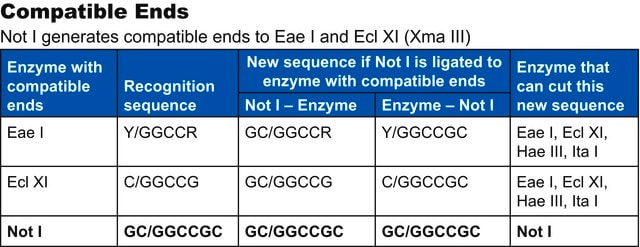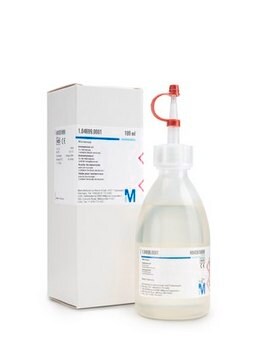추천 제품
생물학적 소스
Escherichia coli
Quality Level
형태
solution
포장
pkg of 1,000 U (10674257001 [10 U/μl])
pkg of 20,000 U (10674273001 [10 U/μl])
pkg of 20,000 U (11047663001 [40 U/μl])
pkg of 5,000 U (10674265001 [10 U/μl])
제조업체/상표
Roche
파라미터
37 °C optimum reaction temp.
기술
DNA sequencing: suitable
저장 온도
−20°C
관련 카테고리
일반 설명
Compatible ends
Xba I ends are compatible with fragments generated by Avr I, Nhe I, and Spe I.
Isoschizomers
The enzyme is not known to have isoschizomers.
Methylation sensitivity
Xba I digestion of DNA is inhibited by the dam gene product of E. coli, which methylates the 6N position of adenine in the sequence GATC. The enzyme is also inhibited by 5-methylcytosine or 5-hydroxymethylcytosine at the site (*) indicated on the recognition sequence.
Activity in SuRE/Cut Buffer System
Buffer printed in bold face type is the buffer recommended for optimal activity:
A B L M H
100% 75-100% 75-100% 75-100% 100%
Relative activity in complete PCR mix
Relative activity in PCR mix (Taq DNA Polymerase buffer) is 60%. The PCR mix contained ?DNA, primers, 10 mM Tris-HCl (pH 8.3, +20°C), 50 mM KCl, 1.5 mM MgCl2, 200 ?M dNTPs, 2.5 U Taq DNA polymerase. The mix was subjected to 25 amplification cycles. Activity in reaction buffer of Pwo SuperYield DNA Polymerase PCR Mix is 25%. When supplemented with GC-RICH Solution, activity increases to 100%.
Incubation temperature
+37°C
Number of cleavage sites on different DNAs
λ Ad2 SV40 ?X174 M13mp7 M13mp18 pBR322 pBR328 pUC18
1 5 0 0 0 1 0 0 1
PFGE tested
Xba I has been tested in Pulsed-Field Gel Electrophoresis (on bacterial chromosomes). For cleavage of genomic DNA (E. coli C 600) embedded in agarose for PFGE analysis, we recommend 10 U enzyme per ?g DNA and approximately 4 hour incubation time.
Ligation and recutting assay
Xba I fragments obtained by complete digestion of 1 ?g pUC18 DNA are ligated with 1 U T4 DNA Ligase in a volume of 10 ?l by incubation for 16 hours at +4°C in 66 mM Tris-HCl, 5 mM MgCl2, 5 mM Dithiothreitol, 1 mM ATP, pH 7.5 (at +20°C) resulting in >90% recovery of pUC18 DNA.
Subsequent re-cutting with Xba I yields >95% of the typical pattern of pUC18 × Xba I fragments.
특이성
The sequence specificity of Xba I is relaxed at low ionic strength or by addition of glycerol, ethanol or DMSO to the incubation mixture.
Recognition sites: TCTAGA
TCTAGA
Restriction site: T↓CTAGA
T↓CTAGA
Heat inactivation: Xba I can be heat inactivated by incubation at 65 °C for 15 minutes (up to 15 U/μg DNA). Higher concentrations of Xba I cannot be heat inactivated completely under these conditions.
애플리케이션
DNA 프로파일
- λ: 1
- φX174: 0
- Ad2: 5
- M13mp7: 0
- pBR322: 0
- pBR328: 0
- pUC18: 1
- SV40: 0
단위 정의
분석 메모
1μg λDNA is incubated for 16 hours in 50 μl SuRE/Cut Buffer H with an excess of Xba I. The number of enzyme units which do not change the enzyme-specific pattern is stated in the certificate of analysis.
Absence of exonuclease activity
Approximately 5 μg [3H] labeled calf thymus DNA are incubated with 3μl Xba I for 4 hours at +37°C in a total volume of 100 μl 50 mM Tris-HCl, 10 mM MgCl2, 1 mM Dithioerythritol, pH approximately 7.5. Under these conditions, no release of radioactivity is detectable, as stated in the certificate of analysis.
The buffer in bold is recommended for optimal activity
- A: 100%
- B: 75-100%
- H: 100%
- L: 75-100%
- M: 75-100%
Relative activity in PCR mix (Taq DNA Polymerase buffer) is 60%. The PCR mix contained λDNA, primers, 10 mM Tris-HCl (pH 8.3, 20 °C), 50 mM KCl, 1.5 mM MgCl2, 200 μM dNTPs, 2.5 U Taq DNA polymerase. The mix was subjected to 25 amplification cycles.Activity in reaction buffer of Pwo SuperYield DNA Polymerase PCR Mix is 25%. When supplemented with GC-RICH Solution, activity increases to 100%. Pwo SuperYield DNA Polymerase PCR Mix is not available in U.S.
기타 정보
키트 구성품 전용
- Enzyme Solution
- SuRE/Cut Buffer H 10x concentrated
Storage Class Code
12 - Non Combustible Liquids
WGK
WGK 1
Flash Point (°F)
does not flash
Flash Point (°C)
does not flash
시험 성적서(COA)
제품의 로트/배치 번호를 입력하여 시험 성적서(COA)을 검색하십시오. 로트 및 배치 번호는 제품 라벨에 있는 ‘로트’ 또는 ‘배치’라는 용어 뒤에서 찾을 수 있습니다.
문서
The term “Restriction enzyme” originated from the studies of Enterobacteria phage λ (lambda phage) in the laboratories of Werner Arber and Matthew Meselson.
관련 콘텐츠
Restriction endonucleases popularly referred to as restriction enzymes, are ubiquitously present in prokaryotes. The function of restriction endonucleases is mainly protection against foreign genetic material especially against bacteriophage DNA.
자사의 과학자팀은 생명 과학, 재료 과학, 화학 합성, 크로마토그래피, 분석 및 기타 많은 영역을 포함한 모든 과학 분야에 경험이 있습니다..
고객지원팀으로 연락바랍니다.







